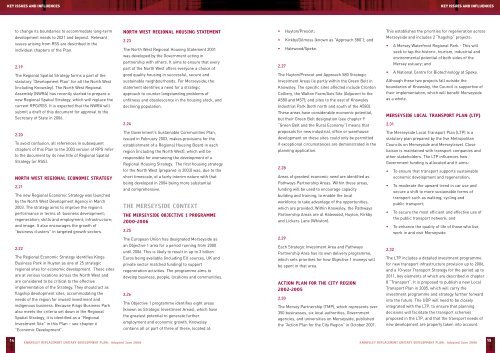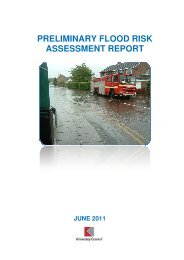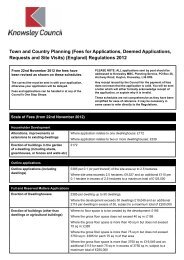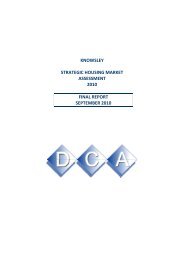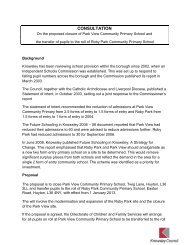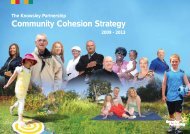Knowsley Replacement Unitary Development Plan - Knowsley Council
Knowsley Replacement Unitary Development Plan - Knowsley Council
Knowsley Replacement Unitary Development Plan - Knowsley Council
You also want an ePaper? Increase the reach of your titles
YUMPU automatically turns print PDFs into web optimized ePapers that Google loves.
KEY ISSUES AND INFLUENCES<br />
KEY ISSUES AND INFLUENCES<br />
to change its boundaries to accommodate long-term<br />
development needs to 2021 and beyond. Relevant<br />
issues arising from RSS are described in the<br />
individual chapters of the <strong>Plan</strong>.<br />
2.19<br />
The Regional Spatial Strategy forms a part of the<br />
statutory “<strong>Development</strong> <strong>Plan</strong>” for all the North West<br />
(including <strong>Knowsley</strong>). The North West Regional<br />
Assembly (NWRA) has recently started to prepare a<br />
new Regional Spatial Strategy, which will replace the<br />
current RPG/RSS. It is expected that the NWRA will<br />
submit a draft of this document for approval to the<br />
Secretary of State in 2006.<br />
2.20<br />
To avoid confusion, all references in subsequent<br />
chapters of this <strong>Plan</strong> to the 2003 version of RPG refer<br />
to the document by its new title of Regional Spatial<br />
Strategy (or RSS).<br />
NORTH WEST REGIONAL ECONOMIC STRATEGY<br />
2.21<br />
The new Regional Economic Strategy was launched<br />
by the North West <strong>Development</strong> Agency in March<br />
2003. The strategy aims to improve the region’s<br />
performance in terms of: business development;<br />
regeneration; skills and employment; infrastructure;<br />
and image. It also encourages the growth of<br />
“business clusters” in targeted growth sectors.<br />
2.22<br />
The Regional Economic Strategy identifies Kings<br />
Business Park in Huyton as one of 25 strategic<br />
regional sites for economic development. These sites<br />
are at various locations across the North West and<br />
are considered to be critical to the effective<br />
implementation of the Strategy. They should act as<br />
flagship development sites, accommodating the<br />
needs of the region for inward investment and<br />
indigenous business. Because Kings Business Park<br />
also meets the criteria set down in the Regional<br />
Spatial Strategy, it is identified as a “Regional<br />
Investment Site” in this <strong>Plan</strong> – see chapter 6<br />
“Economic <strong>Development</strong>”.<br />
NORTH WEST REGIONAL HOUSING STATEMENT<br />
2.23<br />
The North West Regional Housing Statement 2001<br />
was developed by the Government acting in<br />
partnership with others. It aims to ensure that every<br />
part of the North West offers everyone a choice of<br />
good quality housing in successful, secure and<br />
sustainable neighbourhoods. For Merseyside, the<br />
statement identifies a need for a strategic<br />
approach to counter longstanding problems of<br />
unfitness and obsolescence in the housing stock, and<br />
declining population.<br />
2.24<br />
The Government’s Sustainable Communities <strong>Plan</strong>,<br />
issued in February 2003, makes provisions for the<br />
establishment of a Regional Housing Board in each<br />
region (including the North West), which will be<br />
responsible for overseeing the development of a<br />
Regional Housing Strategy. The first housing strategy<br />
for the North West (prepared in 2003) was, due to the<br />
short timescale, of a fairly interim nature with that<br />
being developed in 2004 being more substantial<br />
and comprehensive.<br />
THE MERSEYSIDE CONTEXT<br />
THE MERSEYSIDE OBJECTIVE 1 PROGRAMME<br />
2000-2006<br />
2.25<br />
The European Union has designated Merseyside as<br />
an Objective 1 area for a period running from 2000<br />
until 2006. This is likely to result in up to 3 billion<br />
Euros being available (including EU sources, UK and<br />
private sector matched funding) to support<br />
regeneration activities. The programme aims to<br />
develop business, people, locations and communities.<br />
2.26<br />
The Objective 1 programme identifies eight areas<br />
(known as Strategic Investment Areas), which have<br />
the greatest potential to generate further<br />
employment and economic growth. <strong>Knowsley</strong><br />
contains all or part of three of these, located at:<br />
• Huyton/Prescot;<br />
• Kirkby/Gilmoss (known as “Approach 580”); and<br />
• Halewood/Speke.<br />
2.27<br />
The Huyton/Prescot and Approach 580 Strategic<br />
Investment Areas lie partly within the Green Belt in<br />
<strong>Knowsley</strong>. The specific sites affected include Cronton<br />
Colliery, the Walton Farm/Axis Site (Adjacent to the<br />
A580 and M57); and sites to the east of <strong>Knowsley</strong><br />
Industrial Park (both north and south of the A580).<br />
These areas have considerable economic potential,<br />
but their Green Belt designation (see chapter 9<br />
“Green Belt and the Rural Economy”) means that<br />
proposals for new industrial, office or warehouse<br />
development on these sites could only be permitted<br />
if exceptional circumstances are demonstrated in the<br />
planning application.<br />
2.28<br />
Areas of greatest economic need are identified as<br />
Pathways Partnership Areas. Within these areas,<br />
funding will be used to encourage capacity<br />
building and training, to enable the local<br />
workforce to take advantage of the opportunities,<br />
which are provided. Within <strong>Knowsley</strong>, the Pathways<br />
Partnership Areas are at Halewood, Huyton, Kirkby<br />
and Lickers Lane (Whiston).<br />
2.29<br />
Each Strategic Investment Area and Pathways<br />
Partnership Area has its own delivery programme,<br />
which sets priorities for how Objective 1 moneys will<br />
be spent in that area.<br />
ACTION PLAN FOR THE CITY REGION<br />
2002-2005<br />
2.30<br />
The Mersey Partnership (TMP), which represents over<br />
350 businesses, six local authorities, Government<br />
agencies, and universities on Merseyside, published<br />
the “Action <strong>Plan</strong> for the City Region” in October 2001.<br />
This establishes the priorities for regeneration across<br />
Merseyside and includes 2 “flagship” projects:<br />
• A Mersey Waterfront Regional Park - This will<br />
seek to tap the historic, tourism, industrial and<br />
environmental potential of both sides of the<br />
Mersey estuary; and<br />
• A National Centre for Biotechnology at Speke.<br />
Although these two projects fall outside the<br />
boundaries of <strong>Knowsley</strong>, the <strong>Council</strong> is supportive of<br />
their implementation, which will benefit Merseyside<br />
as a whole.<br />
MERSEYSIDE LOCAL TRANSPORT PLAN (LTP)<br />
2.31<br />
The Merseyside Local Transport <strong>Plan</strong> (LTP) is a<br />
statutory plan prepared by the five Metropolitan<br />
<strong>Council</strong>s on Merseyside and Merseytravel. Close<br />
liaison is maintained with transport companies and<br />
other stakeholders. The LTP influences how<br />
Government funding is allocated and it aims:<br />
• To ensure that transport supports sustainable<br />
economic development and regeneration;<br />
• To moderate the upward trend in car use and<br />
secure a shift to more sustainable forms of<br />
transport such as walking, cycling and<br />
public transport;<br />
• To secure the most efficient and effective use of<br />
the public transport network; and<br />
• To enhance the quality of life of those who live,<br />
work in and visit Merseyside.<br />
2.32<br />
The LTP includes a detailed investment programme<br />
for new transport infrastructure provision up to 2006,<br />
and a 10-year Transport Strategy for the period up to<br />
2011, key elements of which are described in chapter<br />
8 “Transport”. It is proposed to publish a new Local<br />
Transport <strong>Plan</strong> in 2005, which will carry the<br />
investment programme and strategy further forward<br />
into the future. The UDP will need to be closely<br />
integrated with the LTP, to ensure that planning<br />
decisions will facilitate the transport schemes<br />
proposed in the LTP, and that the transport needs of<br />
new development are properly taken into account.<br />
14<br />
KNOWSLEY REPLACEMENT UNITARY DEVELOPMENT PLAN: Adopted June 2006<br />
KNOWSLEY REPLACEMENT UNITARY DEVELOPMENT PLAN: Adopted June 2006<br />
15


